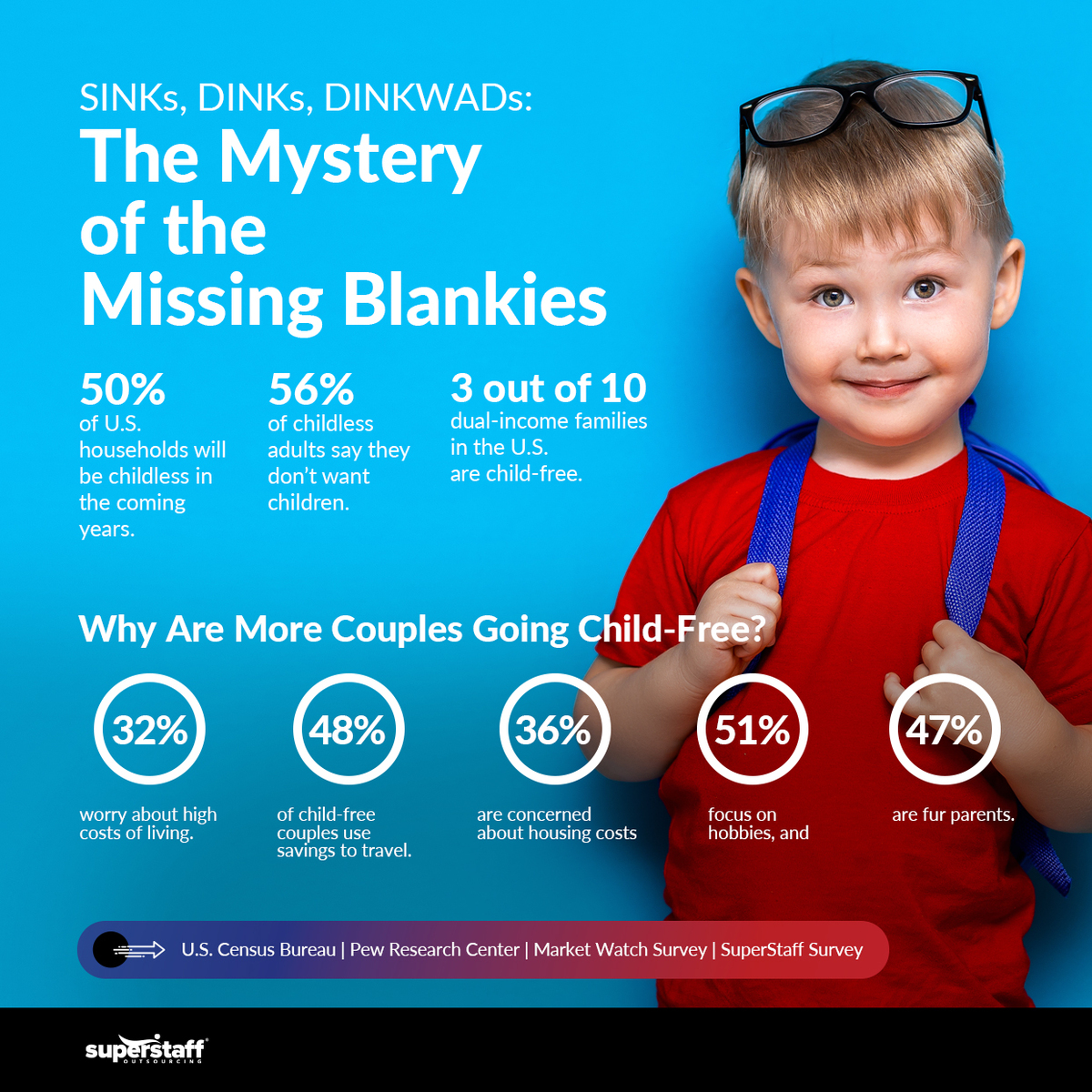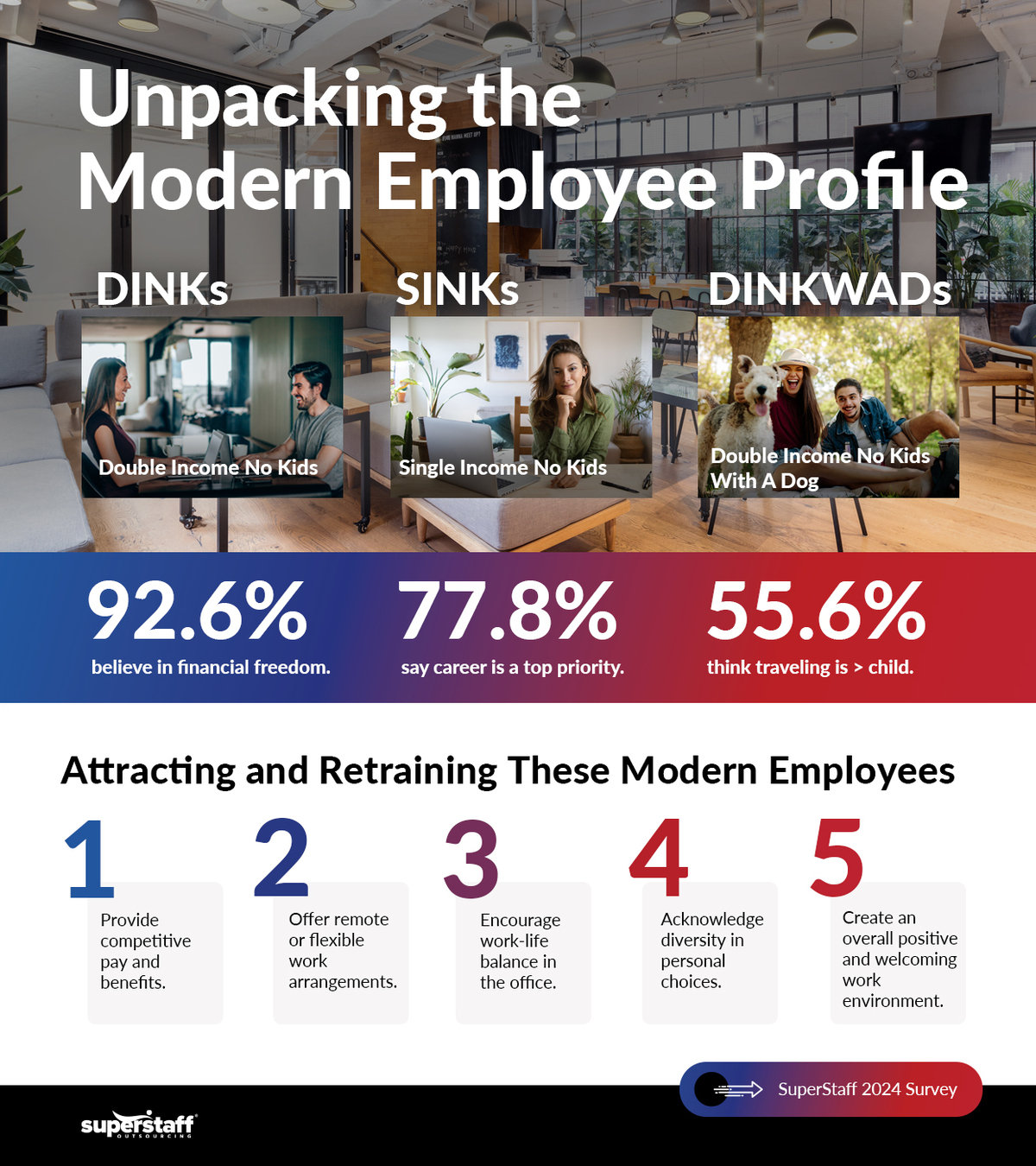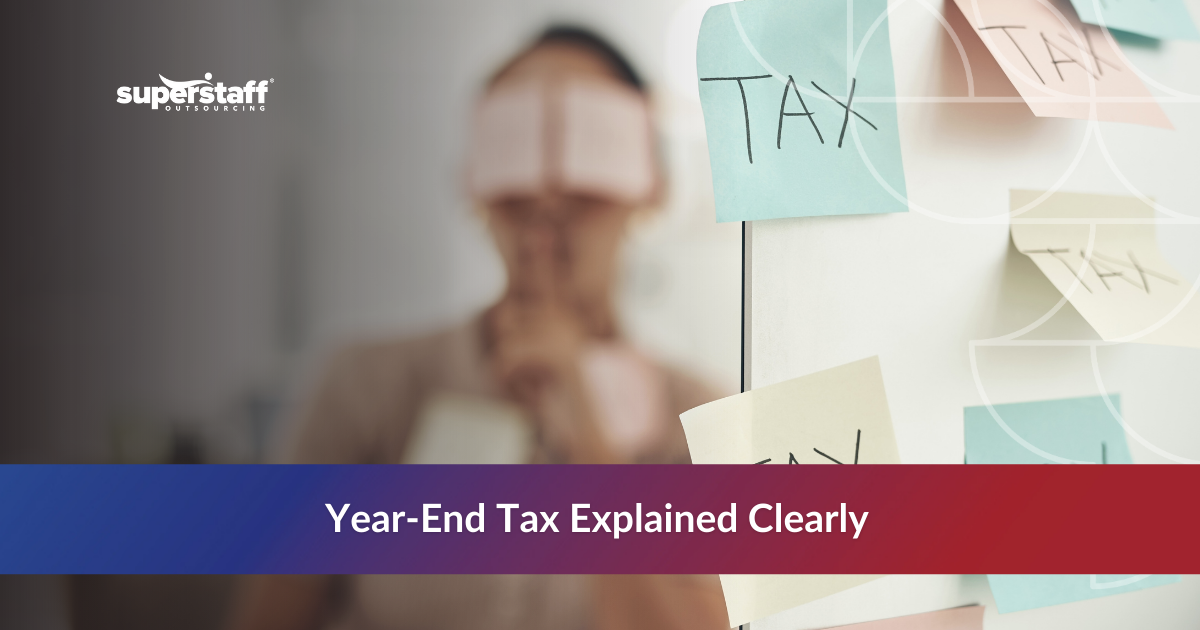
If you’re active on social media, you’ve probably heard of the terms “DINK,” “SINK,” or “DINKWAD.” Maybe you’ve even seen viral videos or photos of couples traveling together or pampering their beloved pooch. Or single people making posts about their savings and investments.
What do these terms mean, and why are people discussing them? Should decision-makers make any changes to their workplaces to accommodate this emerging lifestyle? Let’s dive in and find out!
Behind the Buzzwords: What Is a DINK, SINK, and DINKWAD?
A “DINK” refers to a couple with “double income, no kid.” These couples are usually married and happily child-free or are delaying having children until they reach a certain level of financial stability.
Meanwhile, a “SINK” refers to people with a “single income, no kid.” These individuals are often single by choice and don’t plan on having children. They are often either highly focused on their careers or are passionate about pursuing their hobbies and interests while single.
Much like DINKs, “DINKWADs” are couples with “double income, no kids” but “with a dog.” These married couples are often animal lovers and consider themselves fur-parents to their beloved canines.
What’s Driving the SINK and DINK Lifestyle?
Why are more people, whether singles or couples, choosing to live a child-free lifestyle? Here’s what the research says:
Aspiring to Achieve Financial Stability and Security
According to a MarketWatch survey, financial freedom is the main reason driving the rise of the DINK lifestyle. Over 32% of DINK couples say that they don’t have kids because the cost of living in their country is too high.
Desire for Freedom and Flexibility
Flexibility is another main priority for DINK couples. The same MarketWatch survey highlights that 48% save money by not having children and use their savings to travel.
Decision to Delay or Forego Parenthood for Economic Reasons
Not all DINK couples are 100% child-free. Some are delaying parenthood until they believe they are financially and emotionally prepared for the challenges of raising children.
Economic research shows that the estimated average cost of childcare in the United States in 2024 is $25,714, a 41.5% increase from the eight previous years.
Managing Debt from Education, Housing, or Other Expenses
In addition to childcare costs, other expenses are keeping DINKs from having a kid. For instance, according to AAA, a gallon of gas cost $2.58 in 2019, but it has now risen to $3.12 (as of 2023). Since cars are many people’s primary mode of transportation, inflated gas prices may be a significant factor in their lifestyle choices.
Additionally, many millennial and Gen Z couples are paying off student loan debts, which may stop them from prioritizing parenthood. An Institute for College Access and Success report found that over 62% of college graduates in 2019 owed an average of $28,950.
Housing prices are another factor many DINKs consider. The same MarketWatch survey above found that 36% of couples said they would need to move out of their current home if they had kids. Many admitted that they couldn’t afford a house (18%).
Focus on Career Advancement or Personal Fulfillment
The age-old “career vs. family” debate is another dilemma many DINK couples, particularly women, may think about frequently.
Why is career advancement a concern for many DINKs and SINKs? A Pew Research Center study found that 27% of working parents say that being a mother or father makes it harder to advance their careers. At the same time, 38% admitted that having a job makes it more challenging to be a present parent.
However, the MarketWatch survey shared above found that 55% of DINKs say careers don’t necessarily keep them from deciding to have children. They may care more about personal fulfillment, mainly investing their money in travel (59%), hobbies (51%), and pets (47%).
Striving to Balance Lifestyle Choices with Financial Responsibility
At the end of the day, the common thread driving the SINK and DINK lifestyle is balance.
Child-free singles and couples balance financial security and stability with their desire for a personally fulfilling life (whatever that entails). In their view, children may throw that balance out of the water, so many choose to keep them out of the equation.

Backlash Against DINKs, SINKs, and DINKWADs: What the Critics Say
Despite the growing popularity of SINKs and DINKs, not everyone is a fan of these trends. Here are the common arguments against this lifestyle:
Social Pressure and Expectations
Even as more people begin to explore child-free lifestyles, the assumption that having children is something all couples want is still very ingrained in society. The primary reason for the backlash may be that many still consider it odd (or “against the norm”) to deliberately choose not to have kids.
Criticism of Selfishness or Lack of Responsibility
Many critics perceive the DINK lifestyle as selfish. Instead of considering it a valid personal lifestyle choice, they may view it as prioritizing luxury needs like travel and hobbies over raising a family.
Misconceptions About Lifestyle Choices
Another gripe some critics may have about DINKs is that they are seen as “flaunting their extravagant lifestyle” on social media.
Some child-free couples enjoy promoting their lifestyle online by sharing photos of their travels or luxury homes, complete with a caption about how much money they save by not having kids. Many married folks with children feel uncomfortable about this.
Economic and Cultural Factors
Specific economic factors may also influence people’s feelings about the DINK lifestyle. For instance, Japan has one of the lowest birth rates in the world, declining to below 760,000 in 2023, less than 5.1% from the previous year.
At the same time, Japan has a large population of child-free couples, with an estimated 3.62 million households falling under the DINK category. Due to economists’ concerns about Japan’s aging population and low birth rates, many people may view couples who choose to forego parenthood in an unfavorable light.
Beyond economic issues, cultural factors such as religion may also influence some people’s desire to promote parenthood.
What You Need to Know About SINKs, DINKs, and DINKWADs in 12 Compelling Statistics
Let’s take a deeper look into some of the most compelling data and statistics about the DINK lifestyle:
- The percentage of childless households in the U.S. will approach 50% in the coming years. (U.S. Census Bureau)
- 43% of households in the U.S. are currently childless. (U.S. Census Bureau)
- 29% are single-person households, showing the rise of SINK lifestyles. (U.S. Census Bureau)
- 44% of non-parents between 18 to 49 years old say they never want to have kids. (Pew Research Center)
- 56% of childless adults younger than 50 say they don’t want children. (Pew Research Center)
- The common reasons for not having children are medical reasons (19%), financial issues (17%), and not having a partner (15%). (Pew Research Center)
- The median net worth of couples without children is $399,000, over $150,000 more than those with kids. (Federal Reserve Survey of Consumer Finances)
- Having children adds about $70,000 to a couple’s debt on average. (Federal Reserve Survey of Consumer Finances)
- 3 out of 10 dual-income families in the U.S. are child-free. (Gitnux Market Data Report 2024)
- 15% of American households are considered DINKs. (Gitnux Market Data Report 2024)
- 18% of married couples in the U.S. have no children. (Gitnux Market Data Report 2024)
- 67% of DINK households have a pet. (Gitnux Market Data Report 2024)
SuperStaff Chimes In: What Do Our Employees Think?

We decided to conduct a small internal employee survey to see how they perceive these new lifestyle choices at the workplace. Here are some interesting real-life insights:
- 59.3% of people across generations are familiar with these lifestyle trends but are especially popular among millennials and Gen Zs.
- 92.6% of employees we surveyed agreed that financial freedom is the main reason people today choose not to have children.
Piolo Nuyda, a Gen Z respondent, shared that he prefers the DINK lifestyle because “this is a decision that would allow [him] to plan ahead in life.”
Meanwhile, a millennial respondent said that DINKs “have more disposable income because they do not have the expenses that come with having children.”
In their eyes, having children means sacrificing their financial stability and security. Despite having a dual income, many couples still feel their savings aren’t enough for their desired lifestyle.
- 55.6% say that “love for travel” is why people opt for the DINK lifestyle.
Many couples believe that having kids would not give them the freedom and flexibility to travel the world or spend their weekends going on trips with friends.
Acelin Bliss Suico, a millennial and self-identified DINK, shares her experience: “As per myself and my partner, we already discussed and agreed that when we get married, having kids is going to be off the table and non-negotiable for both of us.
I get to spend more time with my partner. We have the freedom to do anything, eat, travel, or sleep whenever we want without worrying. And we get to enjoy our hard-earned money for ourselves by saving and buying stuff we need and love.”
- 77.8% said that “focus on career” is why many people choose to be child-free.
One Gen Z respondent, who currently identifies as a “DINKWAD,” said the lifestyle is “a valid choice that provides financial flexibility and allows them to focus on career and personal interests without parenting responsibilities. And I think each couple’s lifestyle choice should be respected based on what works best for them.”
- 51.9% believe that people choose the SINK or DINK lifestyle simply because they are not interested in becoming a parent.
One Generation X respondent said, “I am happy being single. I can stand on my own and do not need a companion to complete me. Furthermore, raising a kid is a great responsibility; that is why I do not want to have one.”
One anonymous millennial also mentioned, “It is hard and costly to have kids, and the world’s situation is not getting any better.”
Another millennial respondent shared, “Having kids is a big responsibility for life. If you are not financially prepared and stable, poverty will hit you hard.”
Another respondent who currently identifies as a “SINK,” said, “I would prefer the DINK lifestyle as I feel overwhelmed with responsibilities, and I don’t want to transfer this burden to my future children. It’s essential to me that my children never feel like they are just financial investments.”
Hearthlyn Fiel, a millennial mother of two (soon to be three), shares her advice to people still on the fence about having children: “Being a mother of two boys with a third child on the way, I understand firsthand the immense responsibility that comes with having kids. It’s not to be taken lightly.
If you choose to embark on parenthood, it requires thorough preparation, both physically and financially. However, I fully respect the decision of couples who choose not to have children. Everyone has valid reasons and factors to consider in making such a significant life choice.”
- 25.9% of respondents said that people may choose the SINK or DINK lifestyle because they don’t want added responsibilities.
However, others argue that being a SINK or DINK doesn’t mean you are not being responsible.
One millennial respondent said that being child-free is “the more responsible choice. It is practical and fitting considering the rise in cost of living and inflation.”
Another millennial shared that “not having kids does not mean you don’t have other responsibilities outside your marriage or partner. Some have responsibilities with their parents and family as well. Having kids is such a huge responsibility that you need to consider a lot of factors first before considering having one.”
- Despite social pressure, many SINKs and DINKs among the SuperStaff employees believe that people’s personal choices will still win out in the end.
One Gen Z SINK said, “Societal norms strongly influence our perceptions of family and parenthood. These norms often dictate what we consider a fulfilling life, but it’s crucial for individuals to assess their own values and priorities. This includes deciding whether traditional family structures or alternative lifestyles like the DINK model align with their personal goals.”
A Gen Z respondent, who currently identifies as a “DINKWAD,” shared their desire for parenthood: “Someday, I want to experience the joy of raising children and being a parent. Parenthood is something I look forward to and consider an important part of my future.
Whether a couple chooses to embrace the DINK lifestyle or not is a personal decision based on their values, circumstances, and goals. It’s important to respect diverse choices and lifestyles, as each couple’s path is unique and valid based on what works best for them.”
Meanwhile, a self-identified millennial DINK said that, although they believe that being child-free is a valid lifestyle choice, they still think, “It will be better to have kids and build a family.”
In the end, the survey found that 77.8% of employees believe being child-free is a valid lifestyle choice that should be respected and embraced.
Building Your Dream Team? Here’s How You Can Hire DINKs, SINKs, and DINKWADs
“Should I make any changes to my workplace to make it more appealing to SINKs and DINKs?”
Since many individuals and couples choose this lifestyle, employers can gain a competitive edge by accommodating these workers. Here are a few simple ways you can attract more SINKs and DINKs to work for you:
Highlight competitive pay and benefits.
As mentioned in previous sections, financial security and stability are crucial concerns for DINK households. So, if you want to attract workers with this lifestyle, start by offering competitive pay and benefits. Make sure to highlight this when creating your job postings online.
Provide flexible work arrangements.
Another way to attract SINK and DINK workers is by offering remote or hybrid work arrangements. Because they value flexibility, SINKs and DINKs will be more likely to gravitate toward employers that allow them to work from home or in whichever location they prefer.
Encourage work-life balance.
Beyond competitive pay and flexible work arrangements, SINKs and DINKs also care about work-life balance. Employers can highlight this as one of their brand’s core values on social media, which may capture the attention of child-free individuals.
At the same time, businesses can encourage existing employees to pursue personal fulfillment and growth by providing sufficient paid time off (PTO).
How Can Employers Be More Mindful of SINK, DINK, and DINKWAD Lifestyle Choices?
Once you’ve hired qualified candidates for your business, the next step is reinventing your work culture to ensure your best employees stay. Whether your workers are primarily SINKs, DINKs, DINKWADs, or happily married with kids, here’s what you should prioritize when building your company culture:
Acknowledge diverse choices and households.
Regardless of how many DINKs you may have in your workplace, it’s important to acknowledge diversity in choices. Everyone should feel at home in your office, and no one should be made to feel judged about their lifestyle.
Create a positive and welcoming work environment.
Acknowledging diversity is only the first step. Your goal should be to create a supportive work environment where everyone feels welcome and valued. Encourage people to share different perspectives and nurture a culture of open communication and collaboration.
Enjoyed learning about the DINK lifestyle? Follow SuperStaff for more helpful content!
SuperStaff is a people-centered BPO company that values diversity and inclusion.
If you enjoyed learning about DINKs, SINKs, and DINKWADs, there’s more where that came from. We keep an eye on the latest workplace and business trends so we can share the knowledge with you!
Follow us on Facebook and LinkedIn, or check out the blogs on our website to stay updated on our informative and engaging content.






